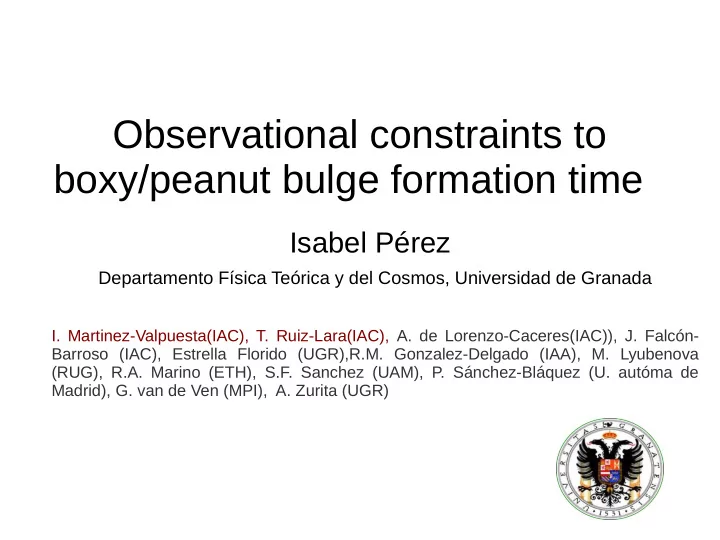

Observational constraints to boxy/peanut bulge formation time Isabel Pérez Departamento Física Teórica y del Cosmos, Universidad de Granada I. Martinez-Valpuesta(IAC), T. Ruiz-Lara(IAC), A. de Lorenzo-Caceres(IAC)), J. Falcón- Barroso (IAC), Estrella Florido (UGR),R.M. Gonzalez-Delgado (IAA), M. Lyubenova (RUG), R.A. Marino (ETH), S.F. Sanchez (UAM), P. Sánchez-Bláquez (U. autóma de Madrid), G. van de Ven (MPI), A. Zurita (UGR)
Observations trace a boxy/peanut structure in the MW V a l e n t i , e t a l . ( 2 0 1 6 ) based on RC stars from VVV
Boxy/peanut are ubiquitous Boxy/peanut shape bulges in more than 40% of disc galaxies (Lutticke et al . 2000). Simulations show that boxy peanut bulges are bars (Combes & Sanders 1981; Athanassoula et al. 2002, Debattista et al. 2006, etc) Observational evidence from spectroscopy of edge-on galaxies (e.g. Kuijken & Merrifield 1995; Bureau & Freeman 1999; Chung Martinez-Valpuesta et al. 2006 & Bureau 2004)
How do B/P bulges look like in less inclined galaxies? Boxy/peanut shape bulges related to bar/lense structures seen face-on (Debattista et al. 2013, Laurikainen et al. 2017, 2014, Athanassoula et al 2015)
When and how bars and boxy/peanut bulges form? - resolved star formation histories (near-field cosmology) CALIFA survey PMAS (Ppak configuration) 3400-7300 Å Final spectral resolution FWHM ~ 6 Å and spatial resolutiion 1” Subsample of 20 barred spirals beloging to size outliers such as NGC6032
When and how bars and boxy/peanut bulges form? - star formation histories: Integrated spectra from elliptical annuli bins
Stellar content analysis different approaches: ● Colours ● Line indices ● Full spectral fitting Sanchez-Blazquez et al. 2011
`` STEllar Content and Kinematics via Maximum A Posteriori likelihood''STECKMAP (Ocvirk 2006) Stellar Population models: MILES (Vazdekis et al. 2010: http://miles.iac.es)
Comparison between CMD and integrated stellar populations: LMC Ruiz-Lara, Pérez, Gallart et al. 2015
Comparison between CMD and integrated stellar populations: LMC EFOSC2 Ruiz-Lara et al. 2015 WFPC2, reaching the oldest MS turn-off Aparicio & Gallart 2004
Comparison between CMD and integrated stellar populations: LMC Good agreement between state-of- the-art resolved stellar analysis and full spectral fitting (Ruiz-Lara, Pérez et al 2015)
When and how bars and boxy/peanut bulges form from star formation histories Integrated spectra from elliptical annuli bins
S n a p s h o t o f b a r a n d b u l g e f o r m a t i o n f r o m t h e S F H o f N G C 6 0 3 2 Pérez, Martinez-Valpuesta et al. 2017. Pérez, Martinez-Valpuesta et al. 2017.
S n a p s h o t o f b a r a n d b u l g e f o r m a t i o n f r o m t h e S F H o f N G C 6 0 3 2 Pérez, Martinez-Valpuesta et al. 2017. Pérez, Martinez-Valpuesta et al. 2017.
Q u e n c h i n g o f t h e S F i n t h e ' i n n e r ' b a r : b a r a s a c o n v e y o r b e l t Pérez, Martinez-Valpuesta et al. 2017.
B a r g r o w s f r o m d i s c m a t e r i a l Pérez, Martinez-Valpuesta et al. 2017. Pérez, Martinez-Valpuesta et al. 2017.
S n a p s h o t o f b a r a n d b u l g e f o r m a t i o n f r o m n u m e r i c a l s i m u l a t i o n s : b a r f o r m a t i o n a n d b u c k l i n g p e r i o d Pérez, Martinez-Valpuesta et al. 2017.
Summary ● The close relation between morphological features and SFHs suggest a long-lasting bar ● The enhancement of star formation in the inner bar suggests, based on the new simulation a relation with the bar formation and main growth, right before the buckling event. In this way we can estimate the buckling occurring around 8 Gyrs ago. We can also infer the formation of the stable disc and the bar at least before 10 Gyrs. ● After the event of the B/P formation, the bar grows again mainly from disc material ● When the bar forms there is a quenching in the star formation of the inner bar, suggesting that the bar can act as a conveyor belt, transferring material to the centre from the disc without forming stars within it.
● Sanchez-Menguiano, Sanchez, Perez et al 2017 accepted (T oday!) ● 102 spiral galaxies with MUSE (part of the AMUSING project) 2D distributions Gas abundances, stellar properties, kinematics, physical properties of HII regions
Recommend
More recommend